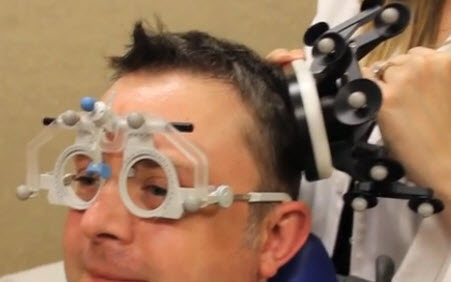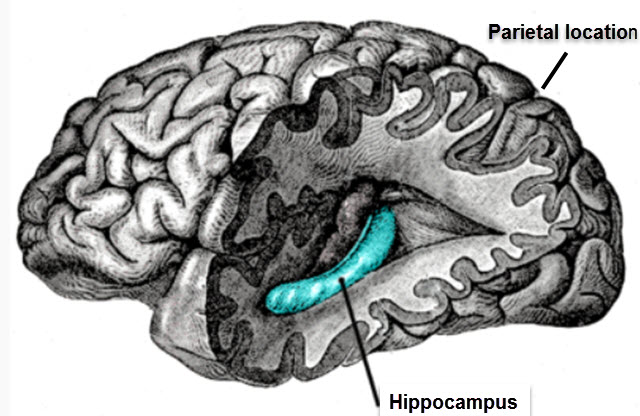Improving memory with transcranial magnetic stimulation
August 29, 2014 | Source: Discovery may help treat memory disorders resulting from stroke, Alzheimer's, and brain injury

Using repetitive transcranial magnetic stimulation (rTMS) to indirectly stimulate the hippocampus (credit: Northwestern University Feinberg School of Medicine)
Northwestern Medicine researchers have discovered that using high-frequency repetitive transcranial magnetic stimulation (rTMS) to indirectly stimulate the hippocampus portion of the brain (which is involved in forming memories) improves long-term memory.
The discovery opens up interesting new possibilities for treating memory impairments caused by conditions such as stroke, early-stage Alzheimer’s disease, traumatic brain injury, and cardiac arrest — along with the memory problems that occur in aging.
“We show for the first time that you can specifically change memory functions of the brain in adults without surgery or drugs, which have not proven effective,” said senior author Joel Voss, assistant professor of medical social sciences at Northwestern University Feinberg School of Medicine. “This noninvasive stimulation improves the ability to learn new things. It has tremendous potential for treating memory disorders.”
The study was published today (August 29) in Science.
The study is also the first to demonstrate that remembering events requires a collection of many brain regions to work in concert with the hippocampus, and that rTMS has the potential of treating mental disorders such as schizophrenia, in which these brain regions and the hippocampus are out of sync with each other, affecting memory and cognition.
Stimulating the hippocampus non-invasively

Indirect stimulation of hippocampus via a parietal lobe location (credit: Wikimedia Commons, adapted)
It isn’t possible to directly stimulate the hippocampus with any form of TMS because it’s too deep in the brain for the magnetic fields to penetrate.
So Voss and colleagues identified a superficial brain region (in the parietal lobe just a centimeter from the surface of the skull) with high neural connectivity to the hippocampus.
When rTMS (induces small electric current in a part of the brain) was used to stimulate this spot, regions in the brain involved with the hippocampus became more synchronized with each other, as indicated by data taken while subjects were inside an MRI machine, which records the blood flow in the brain as an indirect measure of neuronal activity.
The more those regions worked together as a result of the stimulation, the better the subjects were able to learn new information.
Improved memory, more synchronized brain regions
After three days of stimulation, both groups performed better on memory tests as a result of the brain stimulation*.
“They remembered more face-word pairings after the stimulation than before, which means their learning ability improved,” Voss said. “That didn’t happen for the placebo condition or in another control experiment with additional subjects.”
In addition, the MRI showed the stimulation caused the brain regions to become more synchronized with each other and the hippocampus. “The more certain brain regions worked together because of the stimulation, the more people were able to learn face-word pairings, ” Voss said.
“No medication could be as specific as TMS for these memory networks,” noted first author Jane Wang, a postdoctoral fellow in Voss’s lab at Feinberg. “There are a lot of different targets and it’s not easy to come up with any one receptor that’s involved in memory.”
Northwestern University Feinberg School of Medicine
Overcoming brain disorders
“This opens up a whole new area for treatment studies where we will try to see if we can improve function in people who really need it,” Voss said.
His current study was with people who had normal memory, in whom he wouldn’t expect to see a big improvement because their brains are already working effectively. “But for a person with brain damage or a memory disorder, those networks are disrupted, so even a small change could translate into gains in their function,” Voss said.
In an upcoming trial, Voss will study the stimulation’s effect on people with early-stage memory loss.
Voss cautioned that years of research are needed to determine whether this approach is safe or effective for patients with Alzheimer’s disease or similar disorders of memory. Researchers have also cautioned that TMS (especially the repetitive version) has been found to create seizures in some cases.
* Scientists recruited 16 healthy adults ages 21 to 40. Each had a detailed anatomical image taken of his or her brain as well as ten minutes of recording brain activity while lying quietly inside an MRI scanner. Doing this allowed the researchers to identify each person’s network of brain structures that are involved in memory and well connected to the hippocampus. The structures are slightly different in each person and may vary in location by as much as a few centimeters.
Each participant then underwent a memory test, consisting of a set of arbitrary associations between faces and words that they were asked to learn and remember. After establishing their baseline ability to perform on this memory task, participants received brain stimulation 20 minutes a day for five consecutive days.
During the week they also received additional MRI scans and tests of their ability to remember new sets of arbitrary word and face parings to see how their memory changed as a result of the stimulation. Then, at least 24 hours after the final stimulation, they were tested again.
At least one week later, the same experiment was repeated but with a fake placebo stimulation. The order of real stimulation and placebo portions of the study was reversed for half of the participants, and they weren’t told which was which.
Abstract of Science paper
The influential notion that the hippocampus supports associative memory by interacting with functionally distinct and distributed brain regions has not been directly tested in humans. We therefore used targeted noninvasive electromagnetic stimulation to modulate human cortical-hippocampal networks and tested effects of this manipulation on memory. Multiple-session stimulation increased functional connectivity among distributed cortical-hippocampal network regions and concomitantly improved associative memory performance. These alterations involved localized long-term plasticity because increases were highly selective to the targeted brain regions, and enhancements of connectivity and associative memory persisted for ~24 hours after stimulation. Targeted cortical-hippocampal networks can thus be enhanced noninvasively, demonstrating their role in associative memory.